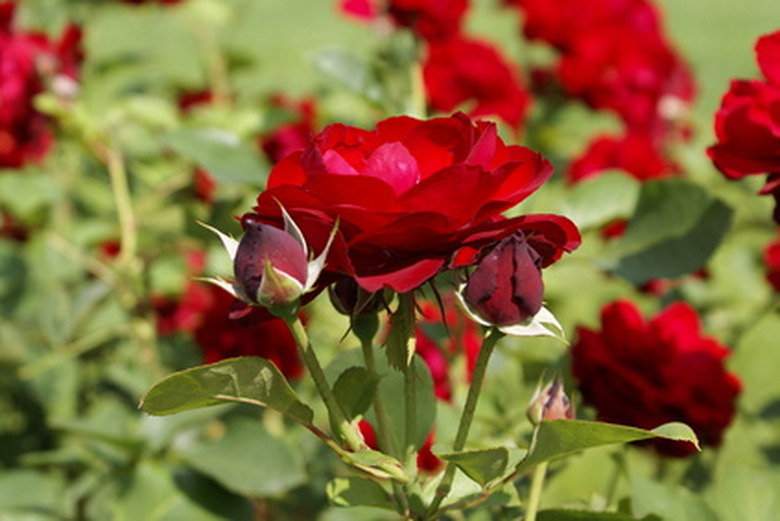At What Temperature Do Rose Bushes Freeze?
We may receive a commission on purchases made from links.
Pruning, fertilizing and winterizing are basic rose gardening chores that need to be followed to keep rose bushes (Rosa spp.) healthy and thriving year after year. The temperatures that make rose bushes freeze vary based on the species and/or cultivar you have and its cold hardiness zone. Shorter days and colder autumn temperatures are signs that rosarians look to when beginning to prepare their rose bushes for the freezing winter days ahead. With proper protection, however, roses can withstand extremely low subfreezing temperatures and still bloom hardily only a few months later.
Tip
Rose bushes have various cold hardiness qualities, which affect the cold temperatures the bushes can handle without being damaged. Some especially cold-hardy cultivars can handle USDA zone 3, which can reach lows of minus 37 to minus 40 degrees Fahrenheit.
Cold Hardiness for Rose Bushes
Cold Hardiness for Rose Bushes
A rose bush's inherent hardiness contributes to its ability to withstand subfreezing temperatures. For example, old garden rose varieties can tolerate extremely cold winters, whereas more modern hybrid tea roses need considerable winter protection to survive the cold undamaged. Roses in the Oso Easy® series have been bred for cold hardiness. Although most roses in this series are cold hardy to zone 4, 'Paprika' and 'Hot Paprika' are hardy to zone 3.
These extremely cold-hardy roses can withstand USDA zone 3 low temperatures of minus 37 to minus 40 degrees Fahrenheit. Acclimation, midwinter hardiness and deacclimation also contribute to a rose's ability to survive freezing cold. Shorter days and decreasing temperatures trigger physiological and biochemical cues in rose bushes that prepare them for winter dormancy.
Early Rose Bush Preparation
Early Rose Bush Preparation
To begin to prepare roses for their winter dormancy, discontinue fertilizing in late summer or early fall, or more specifically, a minimum of one month before your local first-frost date. Continuing to fertilize rose bushes in autumn promotes new growth at a time when the objective is the opposite. Also refrain from deadheading or cutting blooms, and allow the development of rose hips, which encourages the plant to harden for winter. Last, to reduce risk of disease the following year, remove all leaf debris from around the base of the bush.
Complete Rose Winterization
Complete Rose Winterization
Despite the fact that roses can freeze at temperatures below 32 F, basic rose winterization tips help in areas where subfreezing temperatures stay above 20 F. The reason for this is that proper rose winterization keeps the plants cold and frozen throughout winter. The severe damaging effects come not specifically from the cold but rather alternating freezing and thawing.
Therefore, don't cover rose bushes until at least one hard frost occurs for effective rose winter protection. Then remove all dropped leaves and cover the plant with a soil and compost mix approximately 10 to 12 inches deep. After this mound freezes, add further insulation, such as evergreen boughs or straw.
Other Rose Considerations
Other Rose Considerations
In areas with severe winters, like Minnesota and Vermont, additional protection is needed for roses to survive. One popular winterization method uses plastic foam rose cones that fit over bushes. Add a couple ventilation holes, however, to keep air from heating up inside. Another winterization method to consider in Northern regions is the "Minnesota Tip," which means the bush is partially uprooted, pushed over into a trench and covered with soil.
Healthy roses that are properly tended year-round have a greater chance of surviving extremely low subfreezing temperatures than those suffering from pests or diseases. Get into a routine of regular watering, fertilizing and pruning your rose bushes to keep them strong, healthy and ready for cold winter temperatures. When pruning, use sanitized pruning shears to prevent spreading diseases.
